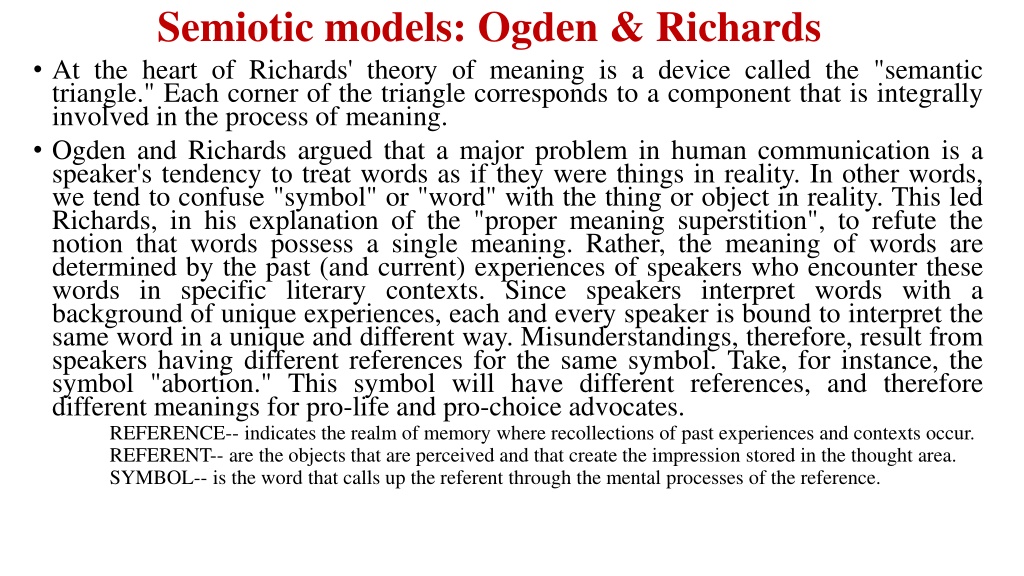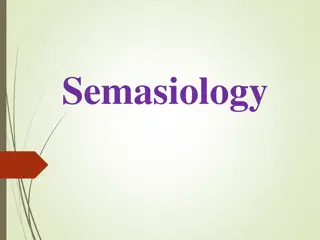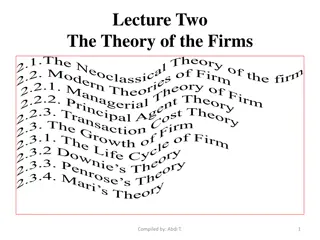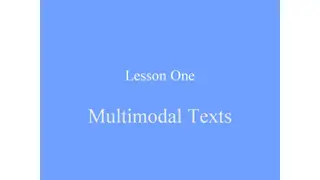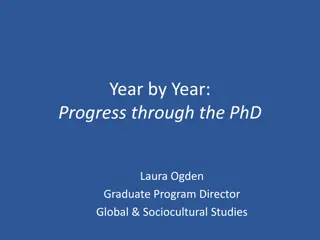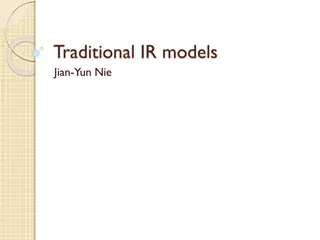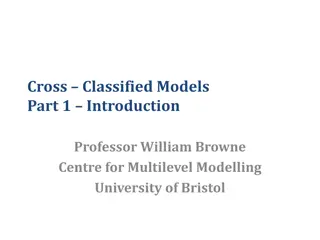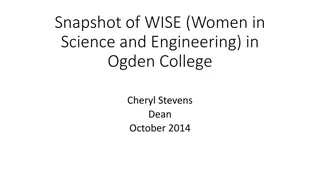Semiotic Models: Theory of Meaning by Ogden & Richards
Ogden & Richards proposed the theory of meaning through the "semantic triangle," emphasizing the role of past experiences in interpreting words. They highlighted the importance of distinguishing symbols from the actual referents to avoid misunderstandings. Additionally, Richards discussed the effectiveness of metaphors in communication, using the concepts of "tenor" and "vehicle." Their theory aims to enhance understanding in human communication by addressing the intricacies of language interpretation and metaphorical expressions.
Download Presentation

Please find below an Image/Link to download the presentation.
The content on the website is provided AS IS for your information and personal use only. It may not be sold, licensed, or shared on other websites without obtaining consent from the author.If you encounter any issues during the download, it is possible that the publisher has removed the file from their server.
You are allowed to download the files provided on this website for personal or commercial use, subject to the condition that they are used lawfully. All files are the property of their respective owners.
The content on the website is provided AS IS for your information and personal use only. It may not be sold, licensed, or shared on other websites without obtaining consent from the author.
E N D
Presentation Transcript
Semiotic models: Ogden & Richards At the heart of Richards' theory of meaning is a device called the "semantic triangle." Each corner of the triangle corresponds to a component that is integrally involved in the process of meaning. Ogden and Richards argued that a major problem in human communication is a speaker's tendency to treat words as if they were things in reality. In other words, we tend to confuse "symbol" or "word" with the thing or object in reality. This led Richards, in his explanation of the "proper meaning superstition", to refute the notion that words possess a single meaning. Rather, the meaning of words are determined by the past (and current) experiences of speakers who encounter these words in specific literary contexts. Since speakers interpret words with a background of unique experiences, each and every speaker is bound to interpret the same word in a unique and different way. Misunderstandings, therefore, result from speakers having different references for the same symbol. Take, for instance, the symbol "abortion." This symbol will have different references, and therefore different meanings for pro-life and pro-choice advocates. REFERENCE-- indicates the realm of memory where recollections of past experiences and contexts occur. REFERENT-- are the objects that are perceived and that create the impression stored in the thought area. SYMBOL-- is the word that calls up the referent through the mental processes of the reference.
Figuratives Richards argues that metaphors are highly effective in facilitating comprehension and therefore minimizing misunderstandings. Richards describes metaphor as "the use of one reference to a group of things between which a given relation holds, for the purpose of facilitating the discrimination of an analogous relation in another group. In the understanding of metaphorical language one reference borrows part of the context of another in an abstract form." Since metaphor reveals the relationship between two disparate objects, it is effective in communicating experiences to others since the speaker may use the listener's knowledge of one of the objects to impart the meaning of the second. In discussing metaphors, Richards makes use of two terms--"tenor" and "vehicle." The tenor refers to the underlying idea or principal subject of the metaphor. The vehicle conveys the underlying idea, the borrowed idea, or what the tenor resembles. For example, in "The sun is a red balloon," the tenor is the sun and the vehicle is the balloon (i.e., characteristics of redness and roundness are being attributed to the sun).
Theory of Meaning Often, when one communicates, he or she does not give any special attention to how he or she communicates. As a result, communication between parties is either diminished or lost altogether. Scholars have spent countless years analyzing human communication and have spent the same amount of time formulating theories that attempt to answer questions pertaining to how we communicate and why we choose the methods we do. One such scholar, I.A. Richards analyzed human communication and co-formulated a theory known as the Theory of Meaning . Ogden and Richards theory attempts to not only describe the approaches humans take when communicating, but also to understand how communication is lost when not done correctly. Generally speaking, in science, a theory is centered on a single idea, which the theoretician wishes to provide an answer. Usually, there is only one component to the theory being generated, that being the single idea that is in question or needs to be explained. Unlike traditional scientists, Ogden and Richards take a completely different approach in developing their theory. Rather than focus on a single idea upon which to base the theory, they deconstruct the idea into many parts, thus creating a multi-faceted theory to explain communication behaviors. The facets explored by Ogden and Richards include Meaning Theory, Definition Theory, and Symbol Theory. Though the focus of this paper is Ogden and Richards theory on symbolic meaning, particularly the Semantic Triangle, it is important to possess a basic understanding of the theories surrounding it in order to better understand how they fit together and enable the Semantic Triangle to function. While this paper will not cover all theories in depth, it will provide a summary containing the overarching ideas contained in each.
Theory of Meaning The Theory of Meaning is a concept that has been present in communication since the first humans learned to communicate. As communicators, we are aware that nearly everything we say has meaning on some level to ourselves as well as those we share our words with. The fundamental difference between how we previously looked at meaning and how Ogden and Richards look at it is that many scholars argue that for every word, there is a single, correct meaning associated with it. Ogden and Richards counter this claim with their theory of Proper Meaning Superstition, which states that there is not a single correct meaning associated with each and every word because each word means something different to each person, or more simply, meanings don t reside in words, they reside in people. Consider, for example, the word cold. Since there are variations in word meaning among people, if one were to ask someone what the word cold means, he or she would likely get a response pertaining to a condition in temperature. However, consider the advent of slang and, again, ask someone what the word cold means and one could receive a response pertaining to types of attitudes expressed toward other people or objects. Now, consider the previous example spread throughout the languages of the world and one could perceive the problem of meaning and how there can be no single correct meaning for any word.
Definition & Symbol Theory In order to correct the problems associated with Meaning Theory, Ogden and Richards developed Definition Theory. It is imperative for one to understand that when a person speaks, the words he or she chooses mean different things to different people. One may agree that a term best suited to describe this condition is ambiguity. According to Ogden and Richards, the best way to solve the ambiguity problem is to provide a definition of various terms or concepts (Erickstad, 1998). This can be accomplished in many ways. One might choose to offer an explicit definition of the term or concept being used, or he or she could opt to use the term in such a way as to project the definition through the combination of other words that share the same universal meaning. For instance, if a speaker stated that another person was cold, based on the example dealing with meaning, two inferences could be drawn. First, one could assume that the person being discussed is physically, or temperately, cold. Similarly, one could infer that the person has projected an attitude that is undesirable toward another person or object. Another option, expressed by Ogden and Richards is the use of metaphor. Metaphors aid in the creation of definitions by forming a link between the word or idea and an experience he or she and the audience may share. If the speaker were to either define the term or use other words to prop up the definition with the use of metaphor, the meaning becomes clear. For instance, if the speaker stated that he or she has spoken to another person who always emits a negative demeanor in conversation and that his or her attitude appears cold the meaning is evident. Finally, Ogden and Richards developed the Symbol Theory in order to explain how words expressed in communication evoke images, thus providing a personal meaning based on experience. Symbols are inherently arbitrary by themselves, however, when used in conjunction with one another, meaning is created for the ideas being expressed. Problems in communication arise when people attempt to communicate through the use of arbitrary words because they have no exact or clear meaning. Words are variables that can assume different meanings depending on the context in which they are used (Erickstad, 1998). A good example of a symbol is text. Text, by itself, is meaningless, as it draws no relation to anything outside itself. However, when we combine text with a word and even a picture, we create a workable definition from which to operate. This is the fundamental principle behind Ogden and Richards theory.
Definition & Symbol Theory Ogden and Richards categorize meanings in terms of signs and symbols where signs are natural representations of something beyond themselves, such as a sound, whereas symbols are specialized types of signs, such as text. In both cases, signs and symbols are meaningless unto themselves. Consider the word cat. Alone, the word has no meaning, as it does not resemble what we perceive to be a cat, nor does it possess any direct link to the sounds or behaviors of a cat, as we know it, thus the word is merely an arbitrary symbol. Ogden and Richards use the idea of natural association to link signs and symbols with actual objects such as a cat. In order to illustrate his point that there is a direct relationship between symbols and thought, Ogden and Richards created the Semantic Triangle. The triangle is a simple model in which the three factors involved with the statement or idea are placed in the corners and the relationships between them are represented by the sides. An example of how this idea works is as follows:
Sign Model One peak of the triangle would be the symbol (a word). Another peak would be a thought, such as words to describe the symbol. Finally, the image we create in our minds would become the referent. Through the use of the Semantic Triangle, Ogden and Richards believe they have found a way to connect all words to their meaning. There are relationships between all three factors, represented by the sides of the triangle. The relationship between the thought and symbol are causal, meaning the symbol evokes an attitude or a proposed effect on another person. Similarly, there is a relationship between the thought and the referent, though the relationship can be either direct, such as something we can see in front of us, or indirect, such as an image or idea about something we have seen in another instance. Finally, the relationship between the symbol and the referent is purely indirect in that it is an arbitrary relationship created by someone who wishes the symbol to represent the referent. As demonstrated by the illustration above, the word dog is associated in the mind of the reader as a particular animal. The word is not the animal, but the association links the two, thus all three elements are required in an irreducible triad for the signs to operate correctly. A unique and fascinating quality of Ogden and Richards theory is that it implies meaning can be arbitrarily exchanged without the need to understand how one another feels. What this means is that so long as definitions are created that all parties agree to, feelings regarding those definitions are inconsequential. In fact, according to Ogden and Richards, Whenever we hear anything said, we spring spontaneously to an immediate conclusion, namely, that the speaker is referring to what we should be referring to were we speaking the words ourselves.
Semantic Triangle This is a fairly well-known semiotic triangle; that of Ogden and Richards, in which the terms used are (a) 'symbol', (b) 'thought or reference' and (c) 'referent' The broken line at the base of the triangle is intended to indicate that there is not necessarily any observable or direct relationship between the sign vehicle and the referent. Unlike Saussure's abstract signified (which is analogous to term B rather than to C) the referent is an 'object'. This need not exclude the reference of signs to abstract concepts and fictional entities as well as to physical things, but Peirce's model allocates a place for an objective reality which Saussure's model did not directly feature (though Peirce was not a naive realist, and argued that all experience is mediated by signs). Note, however, that Peirce emphasized that 'the dependence of the mode of existence of the thing represented upon the mode of this or that representation of it... is contrary to the nature of reality'. The inclusion of a referent in Peirce's model does not automatically make it a better model of the sign than that of Saussure. Indeed, as John Lyons notes: There is considerable disagreement about the details of the triadic analysis even among those who accept that all three components, A, B and C, must be taken into account. Should A be defined as a physical or a mental entity? What is the psychological or ontological status of B? Is C something that is referred to on a particular occasion? Or is it the totality of things that might be referred to by uttering the sign...? Or, yet a third possibility, is it some typical or ideal representative of this class?
Linguistic Signs The historical evidence does indicate a tendency of linguistic signs to evolve from indexical and iconic forms towards symbolic forms. Alphabets were not initially based on the substitution of conventional symbols for sounds. Marcel Danesi notes that 'archaeological research suggests... that the origins of alphabetical writing lie in symbols previously made out of elemental shapes that were used as image- making objects - much like the moulds that figurine and coin-makers use today. Only later did they take on more abstract qualities'. Some of the letters in the Greek and Latin alphabets, of course, derive from iconic signs in Egyptian hieroglyphs. The early scripts of the Mediterranean civilizations used pictographs, ideographs and hieroglyphs. Many of these were iconic signs resembling the objects and actions to which they referred either directly or metaphorically. Over time, picture writing became more symbolic and less iconic. This shift from the iconic to the symbolic may have been 'dictated by the economy of using a chisel or a reed brush'; in general, symbols are semiotically more flexible and efficient. The anthropologist Claude L vi-Strauss identified a similar general movement from motivation to arbitrariness within the conceptual schemes employed by particular cultures
Review of the model Ogden and Richards theories are not flawless, however, and have been challenged over the years. Some critics cite that while symbols and definitions are important to communication, there is more to a conversation than merely what a word may mean to someone. The critic is speaking of nonverbal communication in that other factors are at work that can affect what a person means and nonverbal communication plays a huge role in this area. Even if one were to apply Ogden and Richards Semantic Triangle to an interpersonal conversation, it is possible that the whole picture would fall seriously short of capturing all that is meant by one person and understood by another person. For this reason, the ability to pick up on nonverbal messages becomes imperative. Another problem encountered by the critic is that words are left standing by themselves unless they are spoken in context. An example of this was demonstrated previously in the varying meanings for the word cold. What, perhaps, the critic is failing to recognize is that Ogden and Richards have identified the need to place words in context, thus the creation of Definition Theory. While one might assume that Ogden and Richards theories are not completely correct, he or she should be able to recognize the truth offered in the theories. Whether or not Ogden and Richards claim that their theories are the only answers to the problem of failing communication is a moot point. What is fundamentally more important is the fact that through the study of Ogden and Richards theories, scholars have been afforded a new avenue from which to view communication behaviors and thus have been provided a foundation upon which new theories and models can be formulated. To this end, we might be able to grasp the seemingly infinite number of facets that affect every level of human interaction through communication and in many cases form a better understanding of the insurmountable realm of explanations for these interactions as well as how to best manage them.
References https://perso.limsi.fr/jbb/richards.html by Peter Muntigl http://visual-memory.co.uk/daniel/Documents/S4B/sem02.html by Daniel Chandler http://wobewo.be/semantic-triangle/ http://zimmer.csufresno.edu/~johnca/spch100/4-1-ogden.htm
